RBSE Class 12 Maths Notes Chapter 13 Probability
These comprehensive RBSE Class 12 Maths Notes Chapter 13 Probability will give a brief overview of all the concepts.
Rajasthan Board RBSE Solutions for Class 12 Maths in Hindi Medium & English Medium are part of RBSE Solutions for Class 12. Students can also read RBSE Class 12 Maths Important Questions for exam preparation. Students can also go through RBSE Class 12 Maths Notes to understand and remember the concepts easily.
RBSE Class 12 Maths Chapter 13 Notes Probability
Introduction:
In earlier classes, we have studied the probability as a measure of uncertainty of events in a random experiment. Also axiomatic approach formulated by Russian Mathematician A.N. Kolmogorov (1903-1987) have been disscussed. In this chapter, we shall discuss the important concept of conditional probability of an event given that another event has occured, which will be helpful in understanding the Baye's theorem, multiplication rule of probability and independence of events. In the end of this chapter we will study an important discrete probability distribution which is known as Binomial distribution.
Meaning of Probability:
'Probability' or similar words we often use in our daily life as :
Today storm may come or this year least hope that Gaurav will be passed. These statements shows uncertainity. Mathematical measure of this uncertainity is called probability.
Example : If a coin is tossed then out of head and tail which one appear on top ? Its pre-estimation is not possible because both cases are equally, likely in such cases, we find what is the probability to get a specific result.
Conditional Probability:
If E and F are two events associated with a random experiment, then the probability of combined occurence of events E and F whereas event F has al¬ready occured, is multiplication of their probability. i.e., P(E ∩ F) = F(E).P\(\left(\frac{F}{E}\right)\)
Let, for any experiment sample space is S and its two events are E and F.
Let event E has happened and P(E) ≠ 0.
Since E ⊂ S and event E has happen so all elements of S cannot occur, only those elements of S occur which are exist in E. Thus, in this case reduced sample space will be E. Again, all elements of event E cannot occur, but elements of F which exit in E can occur. Set of these elements is F ∩ E or (E ∩ F).
Thus, probability of event F when event E has already happened p\(\left(\frac{F}{E}\right)\) means to find probability of E ∩ F whereas sample space is S.
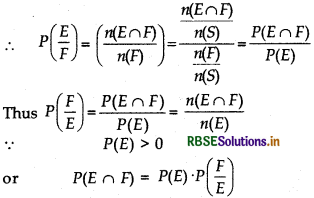
Similarly, probability of event E when event F has already occurred is given by following formula :
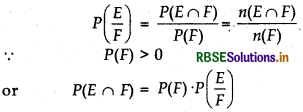

Properties of Conditional Probability:
1. Let E and F are two events of a sample space S, then
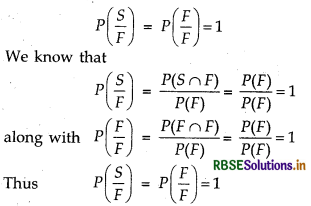
2. If A and B are two events of a sample S and F is another event such that P(F) ≠ 0, then
P[(A ∪ B)/F] = P(A/F) + P(B/F) - P[(A ∩ B)/F]
Specially, if A and B are two mutually exclusive events then
P[(A ∪ B)/F] = P(A/F) + P(B/F) - P[A ∩ B)/F]
Specially, if A and B are two mutually exclusive events then
P[(A ∪ B)/F] = P(A/F) + P(B/F)
We know that
P[(A ∪ B)/F) = \(\frac{P[(A \cup B) \cap F]}{P(F)}\)
= \(\frac{P[(A \cap F) \cup(B \cap F)]}{P(F)}\)
By distribution law of union over intersection of
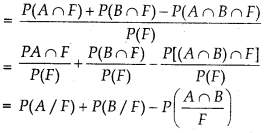
When A and B are mutually exclusive,
P[(A ∩ B)/F] = 0
⇒ P[(A ∪ B)/F] = P(A/F) + P(B/F)
Thus, when A and B are mutually events, then
P\(\left(\frac{A \cup B}{F}\right)\) = P(A/F) + P(B/F)
3. P(E'/F) = 1 - P(E/F)
We know that
P(S/F) = 1
⇒ P[E ∪ F)/F] = 1 [∵ S = E ∪ F]
⇒ P(E/F) + P(E'/F) = 1 [∵ E and F are mutuallly exclusive events]
Thus, P(E'/F) = 1 - P(E/F)
Multiplication Theorem on Probability:
Let E and F be two events associated with a sample space S, then the set E ∩ F denotes the happening of two events E and F.
Example:
In the test of drawing second card after one, we can find probability of compound events a king and a queen. To find probability of event EF use conditional probability which is denoted by P(E/F) and is written as :
P(E/F) = \(\frac{P(E \cap F)}{P(F)}\), P(F) ≠ 0
or P(E ∩ F) = P(F) - P(E/F) ...(i)
Similarly if event E is given then probability of F with condition is expressed as P\(\left(\frac{F}{E}\right)\) and can be written as:
P\(\left(\frac{F}{E}\right)=\frac{P(E \cap F)}{P(E)}\)
Joining two conditions (i) and (ii)
P(E ∩ F) = P(F).P\(\left(\frac{F}{E}\right)\) = P(E).P\(\left(\frac{F}{E}\right)\)
whereas P(E) ≠ 0 and P(F) ≠ 0
Above result is known as multiplication law of probability.

Multiplication Rule of Probability for more than two Events :
Let E, F and G are three events of sample space S then

Thus, the multiplication rule of probability can be extended for four or more events.
Independent Events:
If A and B are two events such that the probability of occurrence of one of them is not affected by occur¬rence of the other. Such events are called independent events.
Two events A and B are said to be independent, if =P(A), provided P(B) * 0
P\(\left(\frac{A}{B}\right)\) = P(A), provided P(B) ≠ 0
and P\(\left(\frac{B}{A}\right)\) = P(B), provided P(A) ≠ 0
By multiplication theorem of probability
P\(\left(\frac{A}{B}\right)\) = P(A)P\(\left(\frac{B}{A}\right)\)
If A and B are independent events, then
P(A ∩ B) = P(A) P(B)
Note : Three events A, B and C are said to be mutually independent if
P(A ∩ B)=P(A). P(B)
P(B ∩ C) =P(B). P(C)
P(A ∩ C) = P(A). P(C)
and P(A ∩ B ∩ C) = P(A). P(B). P(C)
If at least one of the above is not true for three events, we say that the events are not independent.
Bayes’ Theorem:
Suppose, we have two bags A and B. Bag A contains 3 blue and 5 black balls and Bag B contains 6 red and 7 yellow balls. One ball is drawn at random from one of the bags. We can find the probability of selecting any of the bags (i.e. \(\frac{1}{2}\)) or probability of drawing a ball of a particular colour (say blue) from a particular bag (say Bag A). In other words, we can find the probability that the ball drawn is of a particular colour, if we are given the bag from which the ball is drawn. But, can we find the probability that the ball drawn is from a particular bag (say Bag B), if the colour of the ball drawn is given ? Here, we have to find the reverse probability of Bag B to be selected when an event occured after it is known.
Famous mathematician, John Bayes1 solved the problem of finding reverse probability by using conditional probability. The formula developed by him is known as 'Bayes theorem' which was published posthu¬mously in 1763. Before stating and proving the Bayes' theorem, let us first take up a definition and some preliminary results.
Partition of a sample space:
A set of events E1, E2, ..., En represents partition of a sample space S, if
- Ei ∩ Ej = Φ, i ≠ j, i, j = 1, 2, 3, ...........n
- E1 ∪ E2 ∪ E3 ∪ ... ∪ En = S and
- P(Ei) > 0, ∀ i = 1, 2, 3, ..., n
In other words, the events E1, E2, ..., En represent a partition of the sample space S if they are pairwise disjoint, exhaustive and have non-zero probabilities.
Example :
Any non-empty event E and its complement £' form a partition of the sample space S.
∵ E ∩ E'= Φ
and E ∪ E' = S

Theorem of total probability:
Statement:
Let E1, E2, ..., En be a partition of the sample space S, and suppose that each of the events E1, E2, ..., En has non-zero probability of occurrence. Let A be any event associated with S, then
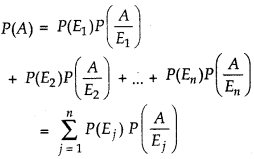
Proof :
Given that,
E1, E2, ..., En is a partition of sample space S.
Ei ∩ Ej = Φ ∀ i ≠ j, i, j = 1, 2, ..., n
We know that for any event A,
A = A ∩ S
= A ∩ (E1 ∪ E2∪ ... ∪ En)
= (A ∩ E1) ∪ (A ∩ E2) ∪ ... ∪ (A ∩ En)
Also A ∩ Ei and A ∩ Ej are respectively the subsets of Ei and Ej. We know that Ei and Ej are disjoint, for i ≠ j, therefore, A ∩ Ei and A ∩ Ej are also disjoint for all
∴ i ≠ j, i, j = 1, 2, ..., n.
∴ P(A) = P[(A n E1) ∪ (A n E2) ∪ ... ∪ (A ∩ E1)]
= P(A ∩ E1) + P(A ∩ E2) + ... + P(A ∩ En)
By multiplication theorem of probability, we have
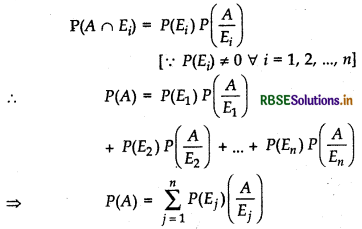
Bayes’ Theorem’s Statement:
If E1, E2,..., En are non empty events which constitute a partition of sample
space S, i.e., E1, E2, ..............En are pairwise disjoint and
E1 ∪ E2 ∪ ... ∪ En = S and A is any event of non-zero probability, then
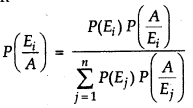
Proof:
We know that
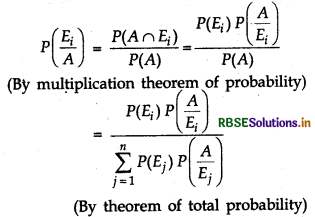
Note :
- E1, E2,..., En are called hypotheses.
- P(Ei) is called the priori probability of hypothesis Ej and the conditional probability P(Ei/ A) is called a posteriori probability of the hypothesis Ej.
Random Variables Distributions:
A random variable is a function whose domain is sample space of any random experiment.
e.g., tossing a coin two times
Following is the sample space of this experiment:
S = {HH, HT, TH, TT}
If X denotes number of head obtained then X is a random variable and for each result its value is given as:
X(HH) = 2, X(HT) = 1, X(TH) = 1, X(TT) = 0
In one sample space, more than one random variable can be defined. Let y denotes number of heads-number of tails for each result of sample space S then
Y(HH), = 2, Y(HT) = 0, Y(TH) = 0, Y(TT) = - 2
Thus, in sample space S, X and Y are defined as two different random variable.

Probability distribution of a random variable:
A tabular distribution gives the values of the random variable along with the corresponding probabilities is called its probability distribution. Let 10 families, whose number of families are respectively 3, 4, 3, 2, 5, 4, 3, 6, 4, 5. Thus random variable can accept any value from X, 2,3,4,5 and 6 which depends on which family is selected. Out of these 10 families, only one family is f4 which has 2 members. Three families are such that f1, f3, f5 each has 3 members. Three families are such that f2, f6, f9 each has 4 members. Two families f5 and f10 are such that each has 5 members and only one family f8 such that which has 6 members. Thus value of X will be only 2, if f4 is selected. Since selection of each family is equally likely.
Thus probability that/4 is selected is \(\frac{1}{10}\). Again, value of random variable X will be 3, if selected family is f4 or f3 or f7. It means
P(X = 2) = \(\frac{1}{10}\), P(X = 3) = \(\frac{3}{10}\), P(X = 4) = \(\frac{3}{10}\),
P(X = 5) = \(\frac{2}{10}\).P(X = 6)= \(\frac{1}{10}\)
Definition :
The probability distribution of random Variable X is system of following numbers:

Here, possible values of random variable X are real numbers x1 x2, x3 ..., xn and pi (i = 1,2,..., n) is probability of acception xi by random variable X. It can be shown as:
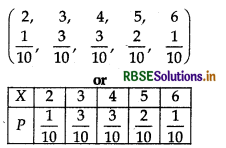
Probability distribution:
A tabular distribution given the values of the random variable along with the correspond¬ing probabilities is called its probability distribution.
Note: If X = xi and P(X): p1 p2, p3 ... pn where pi > 0 and \(\sum_{i=1}^{n}\)pi = 1; i = 1,2,... n.
Meaning of a random variable:
In many problems, it is desirable to describe some feature of the random variable by mean of a single number that can be computed from its probability distribution. Few such numbers are mean, mode and median. In this section, we shall discuss mean only.
Let X be a random variable whose possible values x1, x2, .........,xn occur with probabilities p1, p2,... pn, respectively.
The mean of a random variable X is also called expectation of X, denoted by E(X).
E(X) = µ = \(\sum_{i=1}^{n}\)xiEi
= x1p1 + x2p2 +... + xnpn
Thus, the mean of X, denoted by p, is the weighted aver-age of the possible values of X, each value being weighted by its probability with which it occurs.
Variance of a random variable:
Let X be a random variable whose possible values x1 x2,... xn occur with probabilities p1, p2,... pn respectively. Then the variance of X, is denoted by
var(X) or σx2 = var(X)
= E(X - µ)2 = \(\sum_{i=1}^{n}\)(xi - µ)2Pi
The non-negative number σx is called the standard deviation of the random variable X.
σx = \(\sqrt{{Var}(X)}\)
= +\(\sqrt{\sum_{i=1}^{n}\left(x_{i}-\mu\right)^{2} p_{i}}\)
Another formula to find the variance:
We know that,
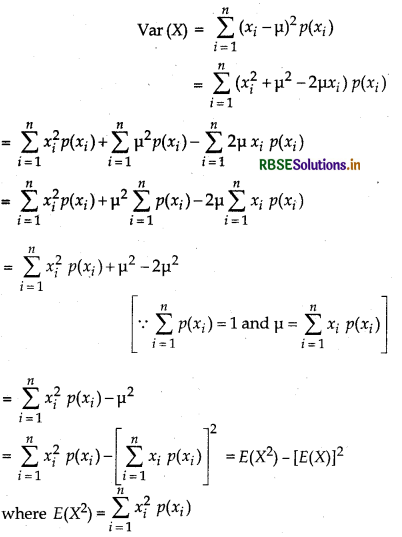

Bernoulli Trials and Binomial Distribution:
Bernoulli trials:
The outcome of any trial is independent of the outcome of any other trial. In each of such trials, the probability of success or failure, remains constant. Such independent trials which have only two outcomes usually referred as 'success' or 'failure' are called Bernoulli trials.
Trials of a random experiment are called Bernoulli trials, if they satisfy the following conditions:
- There should be a finite number of trials.
- The trials should be independent.
- Each trials has exactly two outcomes: success or failure.
- The probability of success remains the same in each trial.
Binomial distribution:
The probability distribution of number of successes in an experiment consistiing of n Bernoulli trials may be obtained by distribution of binomial expansion of (q + p)". Hence, this distribution of number of successes X can be written as:

The above probability distribution is known as binomial distribution with parameters n and p, because for given values of n and p, we can find the complete probability distribution.
The probability of x successes P(X = x) is also denoted by P(x) and is given by
P(x) = nCx qn-x px
x =0, 1,...., n{q = 1 - p)
This P(x) is called the probability function of the binomial distribution. A binomial distribution with n-Bernoulli trials and probability'’ of success in each trial as p, is denoted by B (n, p).
→ The conditional probability of an event A, given the occurrence of the given event B is given by:
P\(\left(\frac{A}{B}\right)=\frac{P(A \cap B)}{P(B)}\); P(B) ≠ 0
Similarly, P\(\left(\frac{A}{B}\right)=\frac{P(A \cap B)}{P(B)}\); P(B) ≠ 0
→ 0 ≤ P\(\left(\frac{A}{B}\right)\) ≤ 1, P\(\left(\frac{\bar{A}}{B}\right)\) = 1 - P\(\left(\frac{A}{B}\right)\)
→ If A and B be two events of sample space S and F be any other events such that P(F) ≠ 0, then
P{(A ∪ B)/F} = P(A/F) + P(B/F) - P\(\left(\frac{A \cap B}{F}\right)\)
Specially, if A and B are disjoint events, them
P(A ∪ B)/F) = P(A/F) + P(B/F)
→ Multiplication Theorem on Probability
P(A ∩ B) = P(A)P\(\left(\frac{B}{A}\right)\)
P(A) ≠ 0 or P(A ≠ B)
= P(B)P\(\left(\frac{A}{B}\right)\); P(B) ≠ 0.
→ If A and B be two independent events, then
P\(\left(\frac{A}{B}\right)\) = P(A),P(A) ≠ 0;
P\(\left(\frac{A}{B}\right)\) = P(A),P(B) ≠ 0;
and P(A ∩ B) = P(A)P(B).
→ Theorem of Total Probability: Let {A1 A2,............... An} be a partition of a sample space and suppose that each of A1 A2,............... An has non-zero probability. Let E be any event associated with S, then
P(E) = P(A1)P\(\left(\frac{E}{A_{1}}\right)\) + P(A2)P\(\left(\frac{E}{A_{2}}\right)\) + .............. + P(An)P\(\left(\frac{E}{A_{n}}\right)\)
= \(\sum_{i=1}^{n}\)P(Ai)P\(\left(\frac{E}{A_{i}}\right)\)
→ Bayes' Theorem : If A1 A2,............... An are events which constitute a partition of sample space, S, i.e., A1 A2,............... An are pairwise disjoint and A1 ∪ A2 ∪ ............... ∪ An = S and E be any event with non-zero probability, then
P(Ai)P\(\left(\frac{E}{A_{i}}\right) = \frac{P\left(A_{i}\right) P\left(\frac{A_{i}}{E}\right)}{\sum_{i=1}^{n} P\left(A_{i}\right) P\left(\frac{A_{i}}{E}\right)}\); i = 1, 2, 3............,n
→ A random variable is a real valued function whose domain is the sample space of a random experiment.
→ The probability distribution of a random variable X is the system of numbers:

where pi > 0, \(\sum_{i=1}^{n}\)pi = 1; i = 1,2, ...................,n
→ Let X be a random variable whose possible values x1 x2, .................. xn occur with probabilities p1, p2, .............. pn respectively.
(a) The mean of X, denoted by p, is the number \(\sum_{i=1}^{n}\)xipi
The mean of a random variable X is also called the expectation of X, denoted by E(X).
(b) Variance of X = var(X) = σx2 = E(X - µ)2 = \(\sum_{i=1}^{n}\)(xi - µ)2 pi
(c) var(X) =E(X2) - {E(X)}2
The non-negative number
σx = +\(\sqrt{{var}(x)}\) = +\(\sqrt{\sum_{i=1}^{n}\left(x_{i}-\mu\right)^{2}\left(x_{i}\right)}\) is called the standard deviation of the random variable X.
→ Trials of-a random experiment are called Bernoulli trials, if they satisfy the following conditions :
- There should be a finite number of trials.
- The trials should be independent.
- Each trial has exactly two outcomes success or failure.
- The probability of success remains the same in each trial.
For Binomial distribution B{n, p), P(X = x) = nCx qn-xpx, x = 0,1,... n (where q = 1 - p)

- RBSE Class 12 Maths Notes Chapter 12 Linear Programming
- RBSE Class 12 Maths Notes Chapter 11 Three Dimensional Geometry
- RBSE Class 12 Maths Notes Chapter 10 Vector Algebra
- RBSE Class 12 Maths Notes Chapter 9 Differential Equations
- RBSE Class 12 Maths Notes Chapter 8 Application of Integrals
- RBSE Class 12 Maths Notes Chapter 7 Integrals
- RBSE Class 12 Maths Notes Chapter 6 Application of Derivatives
- RBSE Class 12 Maths Notes Chapter 5 Continuity and Differentiability
- RBSE Class 12 Maths Notes Chapter 4 Determinants
- RBSE Class 12 Maths Notes Chapter 3 Matrices
- RBSE Class 12 Maths Notes Chapter 2 Inverse Trigonometric Functions